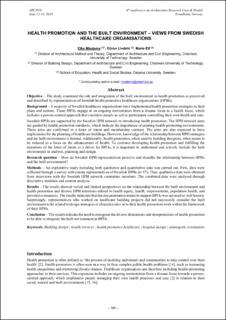| dc.description.abstract | Objective – The study examined the role and integration of the built environment in health promotion as perceived and described by representatives of Swedish health promotive healthcare organisations (HPHs).
Background – A majority of Swedish healthcare organisations have implemented health promotion strategies in their plans and actions. These HPHs engage in an ongoing reorientation from a disease focus to a health focus, which includes a person-centred approach that considers people as active participants controlling their own health and care. Swedish HPHs are supported by the Swedish HPH network in introducing health promotion. The HPH network aims are guided by health promotion standards, which indicate the importance of creating health-promoting environments. These aims are confirmed in a letter of intent and membership contract. The aims are also expected to have implications for the planning of healthcare buildings. However, knowledge of the relationship between HPH strategies and the built environment is limited. Additionally, health promotion, when used by building designers, often seems to be reduced to a focus on the enhancement of health. To continue developing health promotion and fulfilling the intentions of the letter of intent as a driver for HPHs, it is important to understand and actively include the built environment in analysis, planning and design.
Research question – How do Swedish HPH representatives perceive and describe the relationship between HPHs and the built environment?
Methods – An explorative study including both qualitative and quantitative data was carried out. First, data were collected through a survey with county representatives of Swedish HPHs (n=17). Then, qualitative data were obtained from interviews with the Swedish HPH network committee members. The combined data were analysed through descriptive statistics and content analysis.
Results – The results showed varied and limited perspectives on the relationship between the built environment and health promotion and diverse HPH intentions related to health equity, health, empowerment, population health, and preventive measures. The results indicated that the documentation meant to support HPHs was not used or well known. Surprisingly, representatives who worked on healthcare building projects did not necessarily consider the built environment to be related to design strategies or characteristics or to their health promotion work within the framework of their HPHs.
Conclusion – The results indicate the need to recognise the diverse dimensions and interpretations of health promotion to be able to integrate the built environment in HPHs. | |

